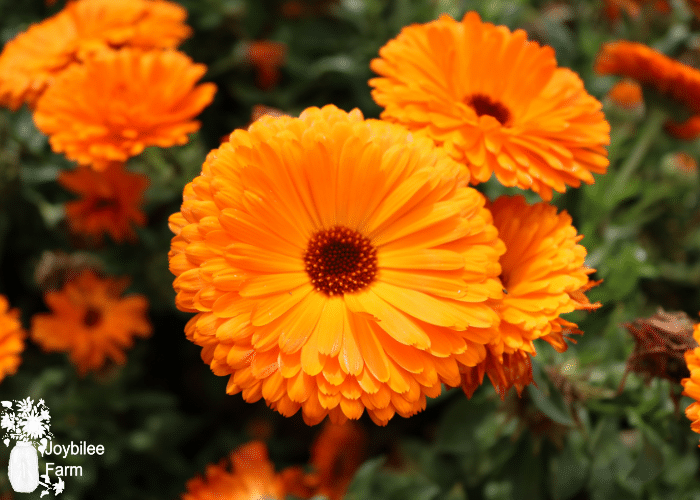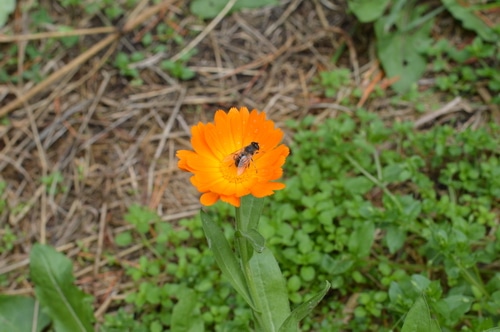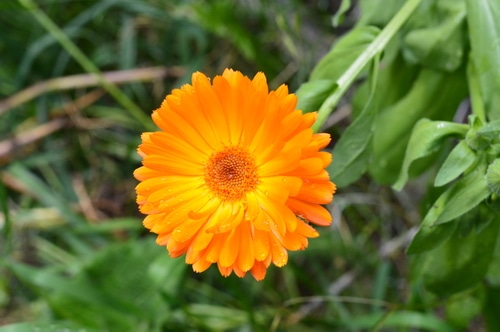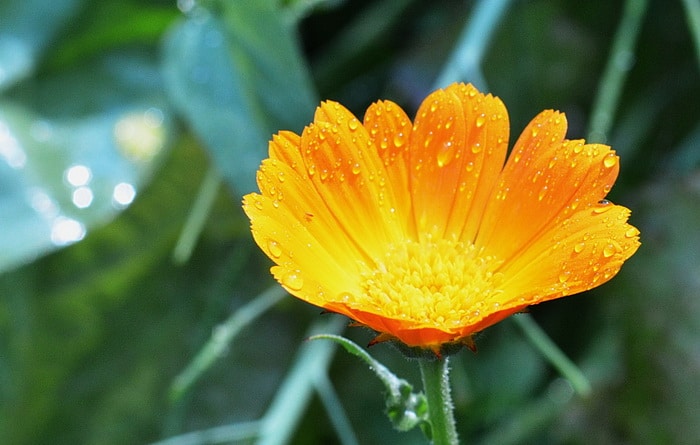It is easy to begin growing calendula for it’s potent, herbal medicine properties. Calendula is used as a skin-care herb, in salves, ointments, and creams. It is also a beautiful flower, and is great for companion planting.
Calendula, also known as pot marigold, is a friendly, and beneficial flower for any garden. It is in the Asteraceae family, along with carrots, parsley, and dandelion. Even if you’re not interested in the herbal benefits, that are myriad, they are awesome for companion planting, decorative flowers, and cut flowers. Their bright yellow, orange, or even straw-pink flowers add a vibrant splash of color to any garden bed.
Calendula officinalis is a resinous flower, often used in oils for skin-care. The flower petals, separated from the resinous calix, have historically been used as a poor man’s saffron substitute, to color butter, cheeses, cream, as a natural dye, and as a bright addition to foods, salads, and more. Calendula is used to sooth sunburn, it’s anti-fungal, and is used to sooth eczema and dry skin. It is a very beneficial herbal ally.
Calendula can sometimes be confused with marigold, tagetes species. For natural dye purposes marigolds have a stronger dye than calendula, but both can be used. However, marigold does not have the medicinal and herbal benefits that calendula does. Marigolds are not edible. Both can be used as bright companion plants in the vegetable garden, or flower beds.

Growing Calendula:
Calendula is a frost sensitive flower, that is grown as an annual in most climates. Zones 9 and above can sometimes grow calendula as a perennial, but the blooms will pause in the heat of summer and it will mostly thrive as a winter flower.
Sowing: Sow seeds directly in the garden 1-2 weeks before last frost date in cool climates. Seeds germinate in 7-14 days. They can also be started indoors, up to 8 weeks before the last frost date.
Transplanting: If started indoors, plant the seedlings out after the danger of frost is past, and they are hardened off.
Spacing: Thin direct sown plants to 4-6 inches apart for best individual growth. Plant seedlings 6 inches apart when transplanting. Calendula plants can thrive close together, but the best blossom production happens with a bit of space.
Care: Calendula like well-drained soil, and can survive inconsistent watering. If companion planted with vegetables or other flowers, the same care given to those is sufficient for calendula. They don’t need much tending, other than consistent deadheading of the spent calendula blossoms. This prolongs bloom time, and helps prevent self-seeding.
Feeding: Calendula don’t need a lot of nutrients during the growing season. Either feed the garden soil with compost, before the growing season starts. Or, feed once or twice during the growing season with something like liquid fish fertilizer. Remember to mulch to preserve moisture around your plants and suppress weeds.

Pollinators love calendula, and the long and persistent blooming of these plants can help attract beneficial insects, and pollinators to your garden throughout the growing season. The single layer calendula are the most attractive to bees, for pollen and for nectar.
Harvesting: Calendula blossoms close at night and re-open in the morning. The best time to harvest calendula is in the early morning, when the dew has just dried but before the heat of the day hits. Use blossoms for skin care, calendula infused olive oil, food, or setting aside the calendula petals to dry for a saffron like substitute. Whole blossoms can be dried for later use in oil infusions or skin care too.
Preserving the calendula blossoms: Dry them in an open basket, whole, to save for making infused oil as needed. Remove petals from the calix, and dry in an open basket, or dehydrator set on low, to use as a spice. For more ideas, here’s five ways to preserve and use your calendula harvest.
In climates with cool summers, calendula can be planted in full sun. In places with hot, dry summers, bloom time can be prolonged by planting with taller plants, or in areas with diffused sunlight, mid-afternoon shade, or partial shade.

Troubleshooting Calendula Challenges:
Calendula is a great companion plant for vegetable and herb gardens, as it is attractive to many beneficial insects. It’s also naturally repellent to aphids, and it’s leaves are not very attractive to snails and slugs.
However, calendula can be affected by powdery mildew, if the area is kept too damp. A simple solution is avoiding getting water on the leaves, and trimming foliage back to increase air flow.
Calendula can also be affected by a fungus called calendula smut. This fungi leaves dark spots with grey centers on the leaves. Trim off affected foliage and discard in municipal waste, rather than composting. Increase air flow and make sure water isn’t splashing the leaves to discourage a re-occurrence.
Plant calendula in different areas, and with different plants each year, to help reduce the chance of fungi and mildew reoccurring. Calendula and marigolds both discourage soil nematodes.

Types of Calendula
When growing calendula, there are an abundance of varieties available. All calendula types can be used for food or medicine, and have similar care and environmental needs.The main differential is color, some differences in flower shape, and some height differences. Most calendula is quite short, that and it’s use in soups and container planting, is why it’s nickname is pot marigold.
For skin care and herbal use, the most commonly grown type is the resinous calendula. This yellow or orange, daisy-like flower has the most resin in it’s calix. Resinous calendula may be simply called calendula, and many calendula mixes have resinous calendula as one of the types in the mix. It’s distinguishing characteristic is a single, or barely double, layer of petals, like a daisy. This is the most common variety used for calendula salve.
Flash calendula have a dark reddish to orange tone on the underside of the petals. This provides a cool contrast between the open, apricot, orange, or yellow flowers and the touch of red on the closed blossoms.
My personal favorite calendula flower is strawberry blond. It has a light pink tone, with yellow highlights and looks stunning as a cut flower, in herb gardens, and the petals contrast beautifully in salads. My local butterflies also like this variety.

Fitting Calendula Into Small Spaces:
Now, how can this plant fit into a small, or already overflowing garden? Pot marigold does great in pots and other containers. If you want to add successfully growing calendula to your gardener checklist, a container, aeroponic, or hydroponic growing method can give you beautiful blossoms. Calendula are recommended to grow in aerogardens! So you can have bright flowers for herbal use, or food, all winter long .
Even in areas that ban edible plants in visible garden beds, calendula are ornamental enough that no one would guess they are also a potent medicinal herb. Plant near taller plants, particularly blue or purple flowered ones, to get the best contrast. Fill a planter with a calendula seed mix, and pair it with a marigold version across the path.
In vegetable gardens, I love using a few calendula plants to divide rows or plots of vegetables. An example is 4-8 rows of one thing, a few calendula spots, and more rows of the next veggie. If you’re just starting a perennial bed, or area, there will be space for calendula by blueberry bushes, raspberry canes, and even strawberry plants.
If you have trees, calendula and marigold both work well in the root zone of many ornamental cherry, apple, and other front-yard trees. Marigold is deer resistant, though calendula can become a deer snack. Plant both, alternating, in the same bed to help confuse deer if planting in an unprotected space.

Benefits of Calendula:
Besides the garden benefits of growing calendula plants, there are also many herbal benefits to this beautiful edible flower. Calendula is anti-viral, antibiotic, and anti-fungal, making it a great choice for lip balms and foot creams. One of calendula’s main commercial uses is in hand creams, lip balms, and body butters.
It is also anti-tumour, anti-inflammatory, and promotes lymph drainage, making it a great addition to teas, salads, and foods. On the tea subject, calendula also soothes menstrual cramps, reduces fever, soothes the stomach, ulcers, and is liver supportive. Finally, it can also reduce bleeding, and scarring, making it great as an addition to your herbal first-aid kit.
Learn more about the benefits of calendula, and other every-day herbs in The DIY Herbal Fellowship! This exclusive, herbal focused, membership has new classes coming out every month. And, you get access to all previous content as soon as you sign up! Come and join us today!




Leave a Reply